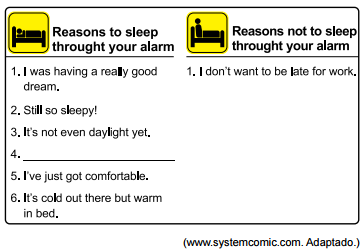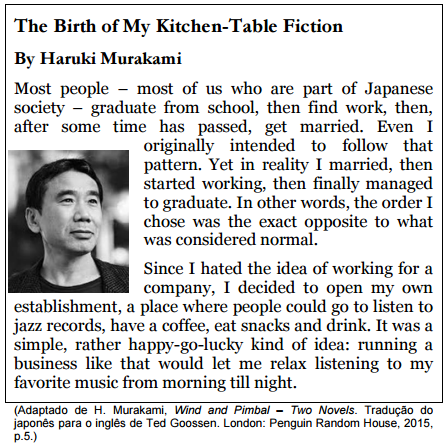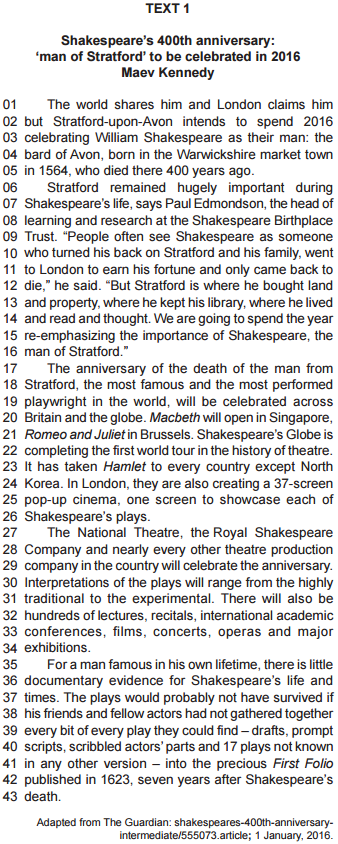Questões de Vestibular
Sobre interpretação de texto | reading comprehension em inglês
Foram encontradas 4.863 questões
INSTRUCTION: Read text 1 and the statements about it to solve question .
I. Shakespeare died in his early 50s.
II. Stratford is one of the places where Shakespeare dwelled in.
III. People from Stratford believe Shakespeare to have been loyal to the city.
IV. Every theater around Great Britain will be praising Shakespeare throughout 2016.
Born on April 15, 1452, in Vinci, Italy, Leonardo da Vinci was the son of a prominent attorney notary and a young peasant girl. Born out of wedlock, he was raised by his father, Ser Piero, and several stepmothers.
His early years were spent living on his father’s family estate in Vinci. Beyond basic reading, writing and mathematical skills, da Vinci did not receive much of a formal education. Recognizing his potential as an artist, his father sent him at the age of 14 or 15 to apprentice with sculptor and painter Andrea del Verrocchio of Florence.
He spent six years honing his technical skills, including metalworking, leather arts, carpentry, drawing and sculpting, and became a member of the Guild of Saint Luke by the age of 20. He remained with Verrocchio until he became an independent master in 1478. Around that time, he took on his first commissioned work, The Adoration of the Magi, for Florence’s San Donato, a Scopeto monastery, but departed for Milan the following year, leaving the painting unfinished. It has been in the Uffizi Gallery in Florence since 1670.
Leonardo was, and is, renowned primarily as a painter. Among his works, the Mona Lisa is the most famous and most parodied portrait and The Last Supper the most reproduced religious painting of all time, with their fame approached only by Michelangelo's The Creation of Adam. Leonardo's drawing of The Vitruvian Man, based on the correlations of ideal human proportions with geometry described by the ancient Roman architect Vitruvius, is also regarded as a cultural icon, being reproduced on items as varied as the euro coin, textbooks, and T-shirts.
Leonardo is also revered for his technological ingenuity. In the early 1490s, he began chronicling his thoughts about painting, architecture, mechanics and human anatomy. These notebooks contained wide-ranging ideas, including plans for a “flying machine,” bicycle and drawings of a fetus in the womb and the human skeleton.
His interests and intellect traversed so many disciplines that he symbolized the term “Renaissance Man”. Unfortunately, these notebooks were not published and his ideas did not advance scientific understanding in the Renaissance period.
Today, Leonardo is widely recognized as one of the most diversely talented individuals ever to have lived.
(Adapted form: http://www.livescience.com/39355-leonardo-da-vinci.html)
Born on April 15, 1452, in Vinci, Italy, Leonardo da Vinci was the son of a prominent attorney notary and a young peasant girl. Born out of wedlock, he was raised by his father, Ser Piero, and several stepmothers.
His early years were spent living on his father’s family estate in Vinci. Beyond basic reading, writing and mathematical skills, da Vinci did not receive much of a formal education. Recognizing his potential as an artist, his father sent him at the age of 14 or 15 to apprentice with sculptor and painter Andrea del Verrocchio of Florence.
He spent six years honing his technical skills, including metalworking, leather arts, carpentry, drawing and sculpting, and became a member of the Guild of Saint Luke by the age of 20. He remained with Verrocchio until he became an independent master in 1478. Around that time, he took on his first commissioned work, The Adoration of the Magi, for Florence’s San Donato, a Scopeto monastery, but departed for Milan the following year, leaving the painting unfinished. It has been in the Uffizi Gallery in Florence since 1670.
Leonardo was, and is, renowned primarily as a painter. Among his works, the Mona Lisa is the most famous and most parodied portrait and The Last Supper the most reproduced religious painting of all time, with their fame approached only by Michelangelo's The Creation of Adam. Leonardo's drawing of The Vitruvian Man, based on the correlations of ideal human proportions with geometry described by the ancient Roman architect Vitruvius, is also regarded as a cultural icon, being reproduced on items as varied as the euro coin, textbooks, and T-shirts.
Leonardo is also revered for his technological ingenuity. In the early 1490s, he began chronicling his thoughts about painting, architecture, mechanics and human anatomy. These notebooks contained wide-ranging ideas, including plans for a “flying machine,” bicycle and drawings of a fetus in the womb and the human skeleton.
His interests and intellect traversed so many disciplines that he symbolized the term “Renaissance Man”. Unfortunately, these notebooks were not published and his ideas did not advance scientific understanding in the Renaissance period.
Today, Leonardo is widely recognized as one of the most diversely talented individuals ever to have lived.
(Adapted form: http://www.livescience.com/39355-leonardo-da-vinci.html)

Born on April 15, 1452, in Vinci, Italy, Leonardo da Vinci was the son of a prominent attorney notary and a young peasant girl. Born out of wedlock, he was raised by his father, Ser Piero, and several stepmothers.
His early years were spent living on his father’s family estate in Vinci. Beyond basic reading, writing and mathematical skills, da Vinci did not receive much of a formal education. Recognizing his potential as an artist, his father sent him at the age of 14 or 15 to apprentice with sculptor and painter Andrea del Verrocchio of Florence.
He spent six years honing his technical skills, including metalworking, leather arts, carpentry, drawing and sculpting, and became a member of the Guild of Saint Luke by the age of 20. He remained with Verrocchio until he became an independent master in 1478. Around that time, he took on his first commissioned work, The Adoration of the Magi, for Florence’s San Donato, a Scopeto monastery, but departed for Milan the following year, leaving the painting unfinished. It has been in the Uffizi Gallery in Florence since 1670.
Leonardo was, and is, renowned primarily as a painter. Among his works, the Mona Lisa is the most famous and most parodied portrait and The Last Supper the most reproduced religious painting of all time, with their fame approached only by Michelangelo's The Creation of Adam. Leonardo's drawing of The Vitruvian Man, based on the correlations of ideal human proportions with geometry described by the ancient Roman architect Vitruvius, is also regarded as a cultural icon, being reproduced on items as varied as the euro coin, textbooks, and T-shirts.
Leonardo is also revered for his technological ingenuity. In the early 1490s, he began chronicling his thoughts about painting, architecture, mechanics and human anatomy. These notebooks contained wide-ranging ideas, including plans for a “flying machine,” bicycle and drawings of a fetus in the womb and the human skeleton.
His interests and intellect traversed so many disciplines that he symbolized the term “Renaissance Man”. Unfortunately, these notebooks were not published and his ideas did not advance scientific understanding in the Renaissance period.
Today, Leonardo is widely recognized as one of the most diversely talented individuals ever to have lived.
(Adapted form: http://www.livescience.com/39355-leonardo-da-vinci.html)
From the above text, one can infer that
Observe o cartum.

A alternativa que completa corretamente a lacuna do
número 4 do cartum, sem prejuízo de sentido, é
Question: Is there anything I can do to train my body to need less sleep?
Karen Weintraub
June 17, 2016

Many people think they can teach themselves to need less sleep, but they’re wrong, said Dr. Sigrid Veasey, a professor at the Center for Sleep and Circadian Neurobiology at the University of Pennsylvania’s Perelman School of Medicine. We might feel that we’re getting by fine on less sleep, but we’re deluding ourselves, Dr. Veasey said, largely because lack of sleep skews our self-awareness. “The more you deprive yourself of sleep over long periods of time, the less accurate you are of judging your own sleep perception,” she said.
Multiple studies have shown that people don’t functionally adapt to less sleep than their bodies need. There is a range of normal sleep times, with most healthy adults naturally needing seven to nine hours of sleep per night, according to the National Sleep Foundation. Those over 65 need about seven to eight hours, on average, while teenagers need eight to 10 hours, and school-age children nine to 11 hours. People’s performance continues to be poor while they are sleep deprived, Dr. Veasey said.
Health issues like pain, sleep apnea or autoimmune disease can increase people’s need for sleep, said Andrea Meredith, a neuroscientist at the University of Maryland School of Medicine. A misalignment of the clock that governs our sleep-wake cycle can also drive up the need for sleep, Dr. Meredith said. The brain’s clock can get misaligned by being stimulated at the wrong time of day, she said, such as from caffeine in the afternoon or evening, digital screen use too close to bedtime, or even exercise at a time of day when the body wants to be winding down.
(http://well.blogs.nytimes.com. Adaptado.)
Question: Is there anything I can do to train my body to need less sleep?
Karen Weintraub
June 17, 2016

Many people think they can teach themselves to need less sleep, but they’re wrong, said Dr. Sigrid Veasey, a professor at the Center for Sleep and Circadian Neurobiology at the University of Pennsylvania’s Perelman School of Medicine. We might feel that we’re getting by fine on less sleep, but we’re deluding ourselves, Dr. Veasey said, largely because lack of sleep skews our self-awareness. “The more you deprive yourself of sleep over long periods of time, the less accurate you are of judging your own sleep perception,” she said.
Multiple studies have shown that people don’t functionally adapt to less sleep than their bodies need. There is a range of normal sleep times, with most healthy adults naturally needing seven to nine hours of sleep per night, according to the National Sleep Foundation. Those over 65 need about seven to eight hours, on average, while teenagers need eight to 10 hours, and school-age children nine to 11 hours. People’s performance continues to be poor while they are sleep deprived, Dr. Veasey said.
Health issues like pain, sleep apnea or autoimmune disease can increase people’s need for sleep, said Andrea Meredith, a neuroscientist at the University of Maryland School of Medicine. A misalignment of the clock that governs our sleep-wake cycle can also drive up the need for sleep, Dr. Meredith said. The brain’s clock can get misaligned by being stimulated at the wrong time of day, she said, such as from caffeine in the afternoon or evening, digital screen use too close to bedtime, or even exercise at a time of day when the body wants to be winding down.
(http://well.blogs.nytimes.com. Adaptado.)
Question: Is there anything I can do to train my body to need less sleep?
Karen Weintraub
June 17, 2016

Many people think they can teach themselves to need less sleep, but they’re wrong, said Dr. Sigrid Veasey, a professor at the Center for Sleep and Circadian Neurobiology at the University of Pennsylvania’s Perelman School of Medicine. We might feel that we’re getting by fine on less sleep, but we’re deluding ourselves, Dr. Veasey said, largely because lack of sleep skews our self-awareness. “The more you deprive yourself of sleep over long periods of time, the less accurate you are of judging your own sleep perception,” she said.
Multiple studies have shown that people don’t functionally adapt to less sleep than their bodies need. There is a range of normal sleep times, with most healthy adults naturally needing seven to nine hours of sleep per night, according to the National Sleep Foundation. Those over 65 need about seven to eight hours, on average, while teenagers need eight to 10 hours, and school-age children nine to 11 hours. People’s performance continues to be poor while they are sleep deprived, Dr. Veasey said.
Health issues like pain, sleep apnea or autoimmune disease can increase people’s need for sleep, said Andrea Meredith, a neuroscientist at the University of Maryland School of Medicine. A misalignment of the clock that governs our sleep-wake cycle can also drive up the need for sleep, Dr. Meredith said. The brain’s clock can get misaligned by being stimulated at the wrong time of day, she said, such as from caffeine in the afternoon or evening, digital screen use too close to bedtime, or even exercise at a time of day when the body wants to be winding down.
(http://well.blogs.nytimes.com. Adaptado.)
Opera
Opera refers to a dramatic art form, originating in Europe, in which the emotional content is conveyed to the audience as much through music, both vocal and instrumental, as it is through the lyrics. By contrast, in musical theater an actor's dramatic performance is primary, and the music plays a lesser role. The drama in opera is presented using the primary elements of theater such as scenery, costumes, and acting. However, the words of the opera, or libretto, are sung rather than spoken. The singers are accompanied by a musical ensemble ranging from a small instrumental ensemble to a full symphonic orchestra.
Disponível em: <http://www.grammarbank.com/short-reading-comprehension-passages.html> . Acesso em: novembro 2014.
Select the alternative that is TRUE, according to the text.
India Cheating Scandal: 600 Students Expelled at Bihar Schools
More than 600 students have been expelled from school in India amid widespread cheating — with some having friends scale the walls of exam centers to pass notes through windows, officials said Friday. The students were among more than 1.4 million high school students taking their 10th grade school finals in the eastern state of Bihar. Many of those caught cheating had smuggled textbooks or scraps of paper to be used for cheating, police and education officials said. Friends, parents and other relatives of the teenagers were seen climbing the sides of some exam centers on Wednesday and Thursday as they tried to reach the windows of the classrooms where the students were taking their exams. They appeared to be trying to pass on cheat sheets with answers written on them. Bihar's education minister, P K Shahi, said the scale of the cheating made it impossible for officials alone to contain and that families should help.
Disponível em:: <http://www.nbcnews.com/news/world/six-hundred-students-caught-cheating-bihar-india-schools-n327066> . Acesso em: abril de 2015.
According to the text, choose the alternative which shows the CORRECT sequence of T (true) or F (false).
I. 600 students quit school.
II. Families tried to help the students to cheat.
III. In the education minister’s perspective, it turned out to be ok the families’ help.
IV. At least 1.4 million students were taking the test.
V. They took this test because they did not have good grades during the semester.
When Garfield says “could’ve used a little salt”, what is he expressing?

Os documentos descobertos em Vindolanda

Depreende-se das informações da figura que
Harry Potter is the best selling book series of all time. But it’s had its reproaches. Various Christian groups claimed the books promoted paganism and witchcraft to children. Washington Post book critic Ron Charles called the fact that adults were also hooked on Potter a "bad case of cultural infantilism.” Charles and others also cited a certain artistic banality in massively commercial story-telling, while others criticized Hogwarts, the wizardry academy attended by Potter, for only rewarding innate talents. The Anglo-American writer Christopher Hitchens, on the other hand, praised J. K. Rowling for freeing English children’s literature from dreams of riches and class and snobbery and giving us a world of youthful democracy and diversity. A growing body of evidence suggests that reading Rowling’s work, at least as a youth, might be a good thing. (Adaptado de http://www.scientificamerican.com/article/why-everyone-shouldread-harry-potter/. Acessado em 02/09/2016.)
A leitura do excerto permite concluir adequadamente que:
Ranking Universities by ‘Greenness’
Universities these days are working hard to improve their sustainability credentials, with efforts that include wind power, organic food and competitions to save energy. They are also adding courses related to sustainability and energy. But which university is the greenest?
Several ranking systems have emerged to offer their take. The Princeton Review recently came out with its second annual green ratings. Fifteen colleges earned the highest possible score — including Harvard, Yale and the University of California, Berkeley.
Another group, the Sustainable Endowment Institute’s GreenReportCard.org, rates colleges on several different areas of green compliance, such as recycling, student involvement and green building. Its top grade for overall excellence, an A-, was earned by 15 schools.
(Adaptado de http://green.blogs.nytimes.com/2009/08/20/ranking-universities-bygreenness/?_r=0.
Acessado em 31/08/2016.)
Conforme o texto, universidades norte-americanas estão
se empenhando para

Considerando o nome da figura - “The Small Talk
Thermometer” -, pode-se depreender que a expressão “small
talk” se refere a

O autor do texto

